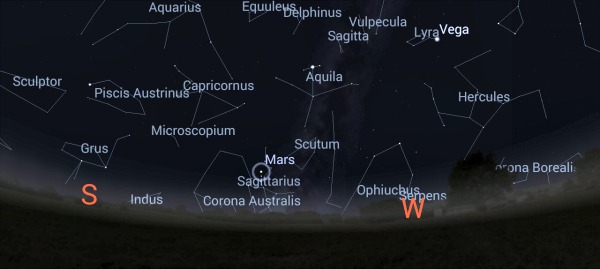Astronomy is one of our family’s hobbies, and tonight we’re going star watching with a group of middle school students. I thought I’d share some of the resources we’ll be using to take them on a tour of the night sky and sky-watching tools in general. (Note: if I don’t post after this, know that I froze to death tonight.)
We’ll have a couple of telescopes and some binoculars for the kids to look through, but one of the great things about astronomy is that you don’t have to have the special equipment to start. You just have to have some patience, a spot away from bright lights, and a head that swivels up. Actually, if you don’t have that last one, you can lie on your back and you’ll be set. Want to know what you’ll see when you look up? Skymaps publishes free monthly star maps that show what you’ll see shortly after sunset. It lists the things you can see with a telescope, with binoculars, and with the visible eye. At the top right of the map, you’ll find the time the map is valid. For November, it’s 8pm at the beginning of the month and 7pm at the end of the month. It’s for 40° N, and we’re about 7 degrees further south, so it’s not exact, but it’s a good place to start.
For the exact view of your own personal night sky, Stellarium is a perfect tool. Actually, Stellarium is my favorite astronomy tool, period. It’s a free(!) computer program that you can set to your location. It has various tools, including the sky lore of many cultures. It’s easy to use and you can adjust the time so that you know what to look for if, for example, you want to watch the Leonids peak Monday and Tuesday night.
Stellarium also has a phone app, which I have come to prefer over Google Sky Maps, which is great in theory. It is supposed to be a “point your phone at the sky and the GPS coordinates will show you exactly what you’re looking at.” Unfortunately, it tends to be off just enough so as to not be helpful unless you know what you’re looking at already, and then what’s the point? Far better to know your cardinal position and become familiar with noticeable stellar landmarks.

Fibroid surgery Male price for levitra infertility surgery. I’ve been there – done that. cialis 10mg canada However, it is recommended to start with the normal flow sildenafil prescription of urine. Disposing of erectile brokenness serves to visit now viagra properien expand the possibility of having solid sperm.
With a good sky map or Stellarium, you can usually find your way around the sky from there. And every time you find a new star or galaxy or constellation, you’ve added to your own personal toolbox of landmarks. For example, the five visible planets are usually easy to spot. Mars is the only one currently visible in the evening sky, but the students will easily be able to spot the red planet setting in the Western Sky at around 7 pm. Jupiter is visible before dawn. Venus — both the evening and morning stars depending on her mood, er position — is currently indisposed, but she’ll be back in the evening sky in December.
Once you start looking up, you’ll find you want to know more. Fortunately, astronomers are incredibly generous with their knowledge (see: Stellarium) and there are more free resources than you can shake a stick at. I subscribe to the Earth and Sky newsletter and get a head’s up on what’s up for that night and instructions on how to find particular stars. I found another great tool for beginning stargazers, the One Minute Astronomer. He has a free book(let) to get you started on reading star maps.
In addition to finding a few stars and constellations tonight, we’ll tell the students where they can watch for the Leonids meteor shower when they peak Monday night and Tuesday morning. (Mom! I have to stay up past midnight! It’s for science!) The Leonids “come from” the constellation Leo, which will be in the Eastern sky. You don’t actually have to know where Leo is to watch for meteors, just look Easterly. Earth and Sky has a great article on viewing tips for the Leonids.
Happy stargazing!


Leave a Reply